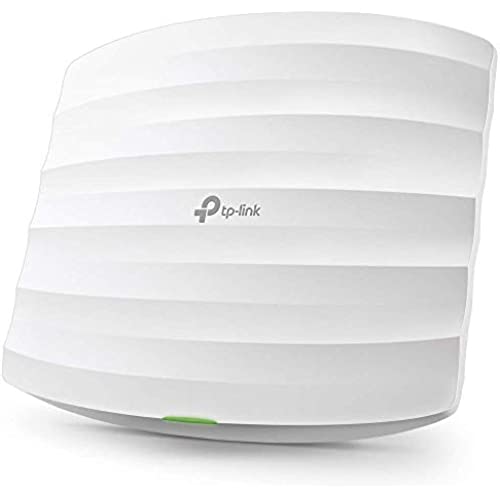
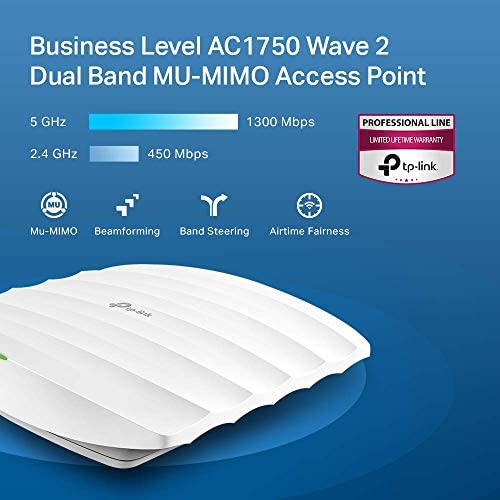
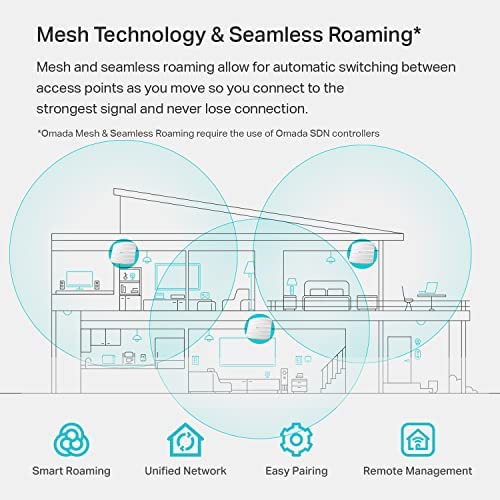
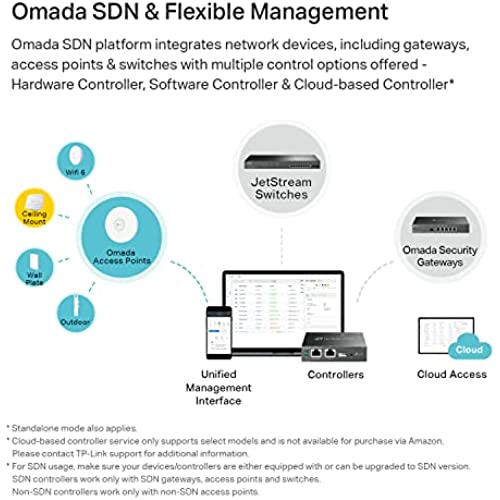
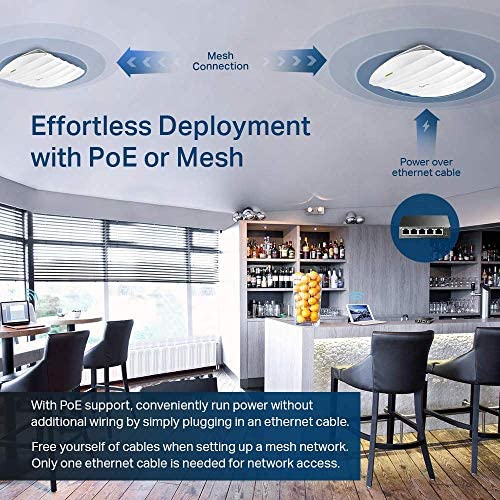
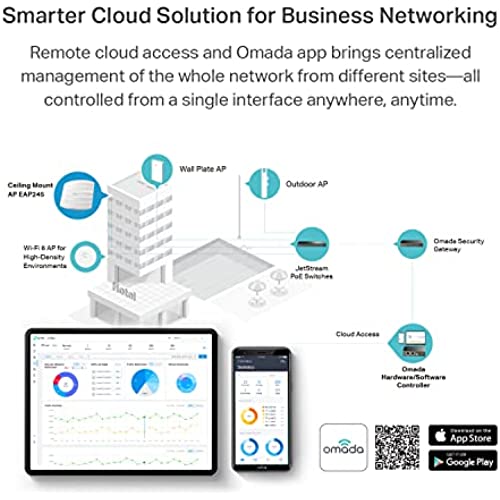








TP-Link EAP245 V3 | Omada AC1750 Gigabit Wireless Access Point | Business WiFi Solution w/ Mesh Support, Seamless Roaming & MU-MIMO | PoE Powered | SDN Integrated | Cloud Access & Omada App | White
-

Istvan
> 3 dayIve been using a bunch of these in SoHo environments and at home too. They coexist with version 1s. Omada controller does the trick: set it and forget it. I do not use any of those cloud apps and easy configs. I install the controller on my notebook, link everything and then when its all set, I occasionally log in through their admin interface to update firmware once in a while. three of these are paired up with a TPLINK C2300, 40+ devices connected at the same time, with seamless roaming between APs. Version 3 (this one) comes with PoE injector, a great addition (with V1 I had to buy it separately ) Easier to deploy and cheaper than the other name brand that starts with an U.
-

John M.
01-06-2025I purchased this item for two reasons: 1. It supports VLANs 2. Simultaneous 450Mbps on 2.4GHz and 1300Mbps on 5GHz totals 1750Mbps Wi-Fi speeds Im a big fan of TP-LINK products in general having owned a number of their wireless routers over the years, and recently purchasing a number of their smart home devices, including smart plug and smart switches - all have performed flawlessly. I purchased the EAP 245 access point to isolate those smart home products on their own VLAN, separate from my home network. In that regard, the EAP-245 WAP worked well - setting up a separate wireless SSID for my smart home items and assigning the VLAN was intuitive and quick - I was able to easily point all my smart home devices to the new VLAN SSID, and all connected without incident. My second reason for buying this unit was to be able to retire my TP-Link AC1750 Archer A7 Smart WiFi Router(configured in access point mode in front of a pfSense router), since the EAP 245 should have been able to handle my home network wireless needs in addition to the separate smart home subnet on its own VLAN. This is where the EAP 245 let me down - while I was able to easily set up my home wireless with my existing SSID and security password, the wireless connection speeds to the EAP 245 were less than half the connection speeds as compared to my old Archer A7 configured in access point mode. Multiple home wireless connection tests with my cell phone yielded 390 mbps or less on the EAP 245, while the Archer A7 connected at 780 mbps. I tried multiple configurations, making sure that only one device was powered on at a time, to insure no interference from the other device. In addition, the EAP 245s coverage to devices on my second floor was marginal. Tests with my laptop yielded similar results - 450mbps speeds connected to my old Archer A7, while the EAP 245 topped out at about 190mbps - all devices I tested were in the same room as both the EAP 245 and the Archer A7. I tried multiple firmware revisions, hoping that perhaps the latest firmware I had loaded upon receipt of the EAP 245 perhaps had introduced a defect that impaired connection speeds in the 5ghz band, but nothing helped. This was a frustrating experience, based on the glowing reviews as well as my previously positive experience with TP-LINK products. I also suspect that a future firmware update may address the issues I experienced with 5ghz connection speeds and range. Ironically, I was able to leave my existing Archer A7 access point in service (performing exceptionally, as it always has), and was able to take a cheap unused ASUS N300 router I had laying around, provision out an untagged VLAN port on my managed switch, and let the ASUS N300 router (in AP mode) handle all the wireless demands of my smart home devices. In the meantime, Im returning this $100 EAP 245 device which was nothing but a disappointment.
-

bigcat
> 3 dayThis thing only works if it’s plugged into the power brick. That defeats the entire purpose of PoE. Could not get it to connect either even after I plugged it into the wall. Falsely advertised waste of time and money.
-

Larry Quah
> 3 dayMy self run company installs network for SMEs and this works out well for my customer to expand his network to the production floor without running cables.
-

Devin
> 3 dayEasy to use ... its been up for over a month now .... no problems ... looking to add another one
-

Stephen Q.
> 3 dayOutstanding, professional quality wifi access point...hands down winner. So many configuration possibilities and easy remote management. Love it.
-

jose
> 3 dayI am and IT consultant. I put APs in all the time. I used to use Engenius but they dropped phone support. If you are a vendor and you have no phone support you dont have me. I tried the tplink waps and was surprised. I like them due to their integrated interface and their simplicity and their gigabit poe network interface. They are also quite hardy. I have not had one die yet (knocking on wood). So to summarize: Excellent Price Point, Excellent device performance, phone support if you need it but after you install one or two of these, you will not need a lot of support unless the device goes bad. If you need a good indoor wap, you will not go wrong by purchasing one of these guys.
-

Min-Gu Park
> 3 dayEasy to install, easy to setup.
-

Robert M
> 3 dayIm just getting this setup but I like the fact that there are many ways to connect it: There are two modes to manage this device and each of these has multiple clients: 1. Standalone mode using a web browser. This is the way nearly all consumer Ap work so it should be familiar. 2. Standalone mode using the Omada App for iOS or Android 3. Controller Mode using the software controller application for Windows or Linux you need to download and install. Using this method you can either access the AP directly or remotely via the cloud. 4. Controller Mode using the Omada App 5. Controller Mode using the OC-200 Omada Cloud Controller which is a dedicate hardware based controller you can buy for less than 100.
-

Casey H.
> 3 dayMaybe I got a bad unit, but the signal drops on mine *constantly*, with the EAP245 v3 on 2.21 firmware from 18 August 2020. Unfortunately, the only solution Ive ever seen online for this issue is to upgrade the firmware. Well, I have. Repeatedly. And frankly the problem got worse. It is especially bad with mobile devices, and my phone has terrible issues with this WAP (iPhone 11 Pro Max). The issues arent as bad with my iPad Pro, but connectivity still drops. I thought maybe the unit was restarting itself repeatedly during the day, but no, it never shows an uptime reset, so that isnt what is happening. I have tried multiple patch cables, multiple locations in my house, and even multiple PoE switches (Ubiquiti and TP-Link). None of these have resolved this issue. When it does stay connected, the speeds are great! 700-800Mbps for 5GHz wireless AC clients, but the 2.4GHz performance is abysmal, with often sub-50Mbps speeds. My Apple TV 4K cannot even stream 1080p reliably on the 2.4GHz band, but has no issues (until the signal drops) on 5GHz. I dumped all of my Ubiquiti gear to get away from their needlessly complicated management system and thought the TP-Link was the answer to my prayers. I have had great with all of the other TP-Link devices Ive ever used, and I have an Archer C9 in a closet that was rock solid (where a UniFi AC Lite was not at all). Unfortunately, that Archer is going back on duty as I cant take these constant signal drops any longer. I have also tried playing around with manually setting the 2.4/5 channels, as well as letting the firmware do it for me. None of them have fixed this issue, and its been 3 months since a firmware update so either TP-Link thinks they fixed it, or I have a hardware issue and Im now out of warranty.
